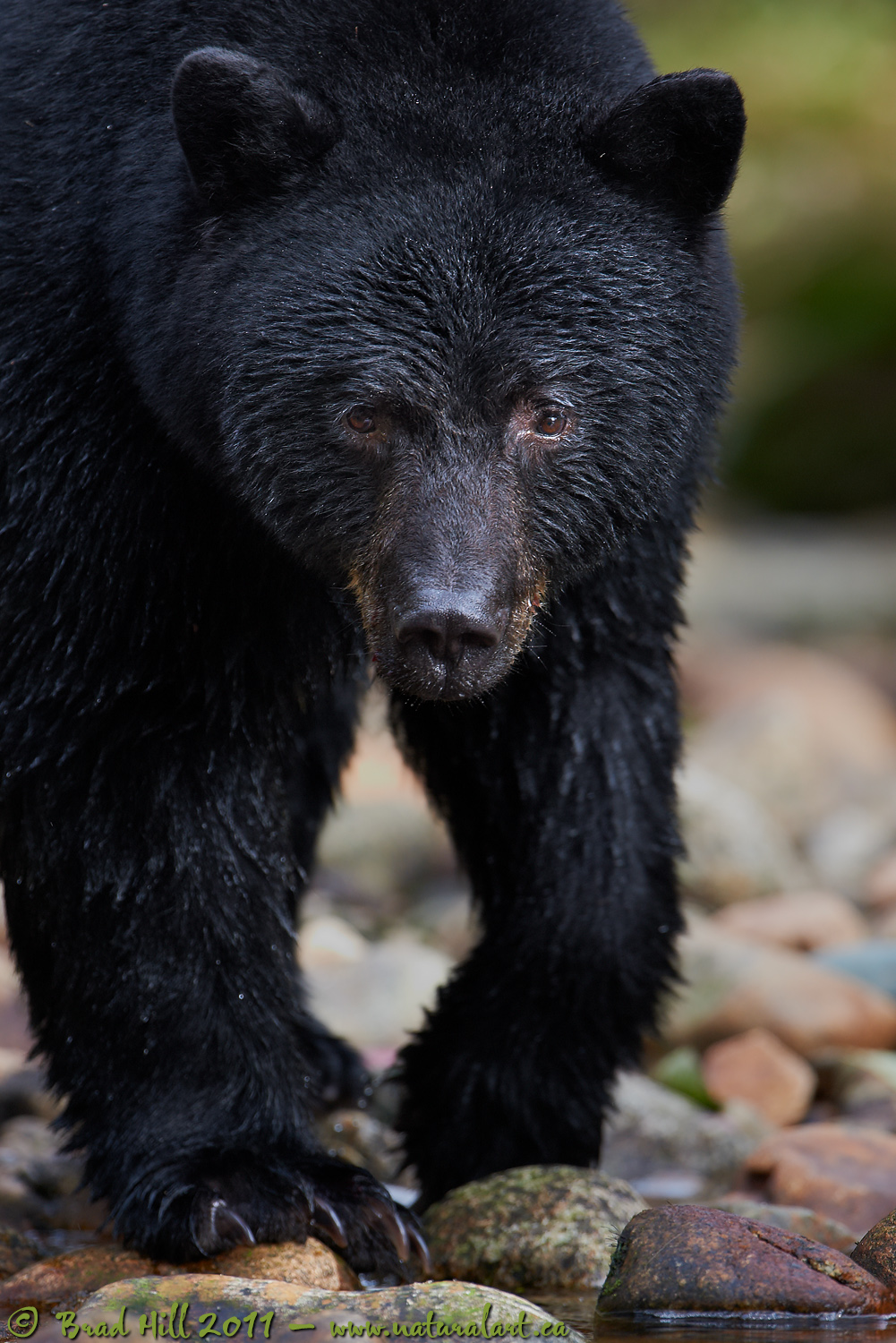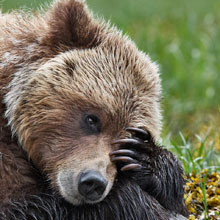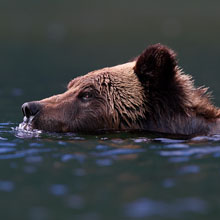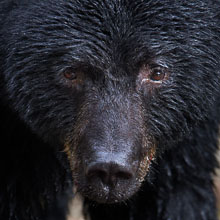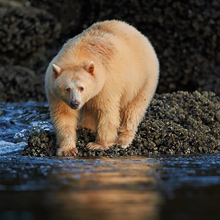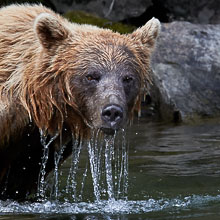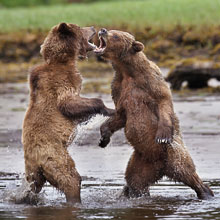Availability: Undetermined - Enquiries?
In the Field
Words Not Required! Great Bear Rainforest (central BC coast), BC, Canada. September 28, 2009.
During my short academic career I did research on vocal and non-vocal communication in animals. Since then I've always been fascinated by how universal non-verbal communication is (i.e., how much of it crosses the lines between species) and by just how much can be communicated without a single word being spoken. If anyone doesn't think that non-human animals actively communicate their emotions (and ponder some pretty complex things) then they're either not really watching the wildlife they're looking at or they're just choosing to ignore what they're seeing (and what the animal is clearly "saying" to them). If this bear's posture and facial features aren't directly telling me both that he's intrigued by my presence but all the while feeling a little ambivalent about what to do next (and pondering his options), well...
I really like shooting what I call "active portraits" - fairly "tight" shots where the subject is doing more than just sitting there and the resulting image conveys a little about the animal's "personality". The powerful eye contact of this black bear is the dominant "theme" in this shot, but the implied motion of the bear's left paw - while being fairly subtle - still adds a little dynamism to this image and, at least to me, makes the shot much more interesting (and certainly helps put it in the category of "active portrait").
Whenever I'm working closely with an animal - like when shooting these active portraits - I like to include enough visual information about the the animal's surroundings to put it in the right environmental context but not so much detail that it becomes visually distracting. This is one major reason why I'm so darned anal about trying to control and use depth-of-field (or DoF) effectively in the field. I always want key areas of the image - those spots where I want the viewer's eye going FIRST - rendered sharply. In the case of this image I wanted the entire head of the bear (and, of course, especially the eyes) very sharp. But, as much as this, I also wanted most of the rest of the image rendered softly and out-of-focus. I knew a few of the foreground rocks would be sharp and was pleased after the fact when it turned out the rocks with water lapping at them were the sharp ones!
But what about the raised leg and the claws? Would it have been better if they were "tack" sharp? Should I have stopped down and widened my DoF? I had the light to do so, but to my way of thinking - no. In my opinion, both of these elements are sharp enough to "do their job" while not competing as much visually with the head as they might if they were really sharp. And, of course, pulling those elements into reasonably sharp focus would have meant stopping down to at least f8 (or possibly f11) and then the distant background would have been much less smooth, more detailed, and more distracting.
ADDITIONAL NOTES:
1. This image - in all resolutions - is protected by copyright. I'm fine with personal uses of them (including use as desktop backgrounds or screensavers on your own computer), but unauthorized commercial use of the image is prohibited by law. Thanks in advance for respecting my copyright!
2. This image was captured during one of my autumn "Into the Great Bear Rainforest" photo tours in 2009. Each year I offer trips into two different parts of the Great Bear Rainforest as well as one to photograph marine mammals and oceanscapes near the northern tip of Vancouver Island. And, in selected years, I also offer photo tours to additional locations to capture other highly sought-after subjects, such as various boreal owl species, fishing grizzlies, and more. Details about these trips can be found on the Photo Tours page of this website.
3. Like all wildlife images on this website, the subject(s) is/are fully wild and completely unconstrained. Besides the potential impact of my/our presence, nothing has been done to intentionally alter or affect the ongoing behavior of the subject and, of course, there has been no use of any form of bait or other form of wildlife attractants (including vocalizations or other sounds).
Behind the Camera
Words Not Required! Great Bear Rainforest (central BC coast), BC, Canada. September 28, 2009.
Digital Capture; RAW 14-bit format; ISO 720.
Nikon D700 with Nikkor 600mm f4 VR lens supported on Gitzo 1348 tripod with Wimberley head. VR on and set to "Normal" mode.
1/250s @ f5; -0.33 stop compensation from matrix-metered exposure setting.
At the Computer
Words Not Required! Great Bear Rainforest (central BC coast), BC, Canada. September 28, 2009.
RAW Conversion to 16-bit TIFF, including first-pass/capture sharpening using Phase One's Capture One Pro 6. Four raw conversions varying in exposure settings from -1.5 stops (for distant background) through to +0.25 stops (for portions of the bear's head). Intermediate exposures used to emphasize black-on-black (or dark on darker!) detail in the bear's coat.
Further digital corrections on 16-bit TIFF file using Adobe's Photoshop CS5. Photoshop adjustments included compositing and blending the four exposure versions, selective exposure and tone curve adjustment, selective colour saturation and desaturation, and selective sharpening for web output.
Conservation
Words Not Required! Great Bear Rainforest (central BC coast), BC, Canada. September 28, 2009.
Ten percent of the revenue generated by this image will be donated to Raincoast*.
Species Status in Canada**: Not currently listed as Threatened or Endangered.
This black bear is a member of the subspecies "Kermodei" (Ursus americana kermodei). This subspecies is unique in that the population is characterized by having an unusually high proportion of a recessive gene that produces white coat colour (found on the "Spirit Bears"). Because the Black Bear is not considered under threat as a species, both the Kermodei subspecies and the very rare Spirit Bear suffer from having the same conservation designation (it should be acknowledged that in British Columbia - the jurisdiction of greatest Spirit Bear abundance - hunting of these white-coated bears is not permitted). For reasons that are not fully understood, the Spirit Bear occurs with greater frequency in a relatively small geographic area within The Great Bear Rainforest of the central and northern coast of British Columbia. In this area 10 to 30% of the bears possess white coats. Many of the black-coloured Black Bears in this region carry the gene for white coats, so allowing hunting of ANY Black Bears in this region can reduce the frequency of the gene for white coats. Thus, to protect the Spirit Bear, it is necessary to prohibit the hunting of ALL Black Bears in this region. And, very unfortunately, the globally unique ecosystem that contains the Spirit Bear is under development pressure, especially from the forestry industry. If this unique environment is altered, we may lose the wonderful genetic anomaly known as the Spirit Bear forever.
*The Raincoast Conservation Society (and Foundation) is an effective and efficient organization that has been fighting for protection of this unique habitat. If you are looking for a meaningful way to contribute to the conservation of this amazing ecosystem, Raincoast will provide maximal "bang" for your conservation dollars.
**as determined by COSEWIC: The Committee on the Status of Endangered Wildlife in Canada












